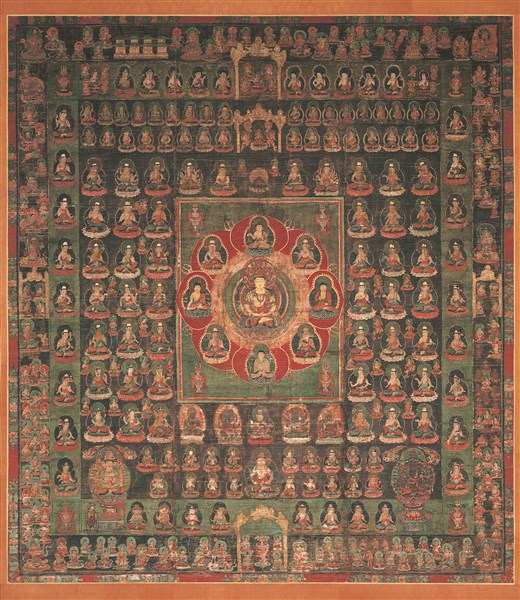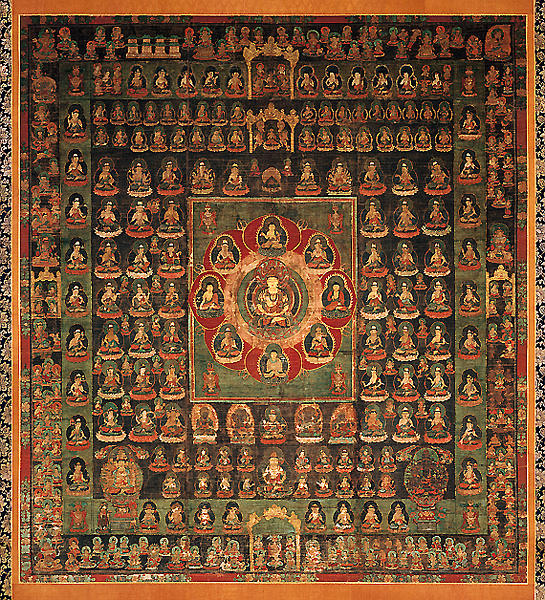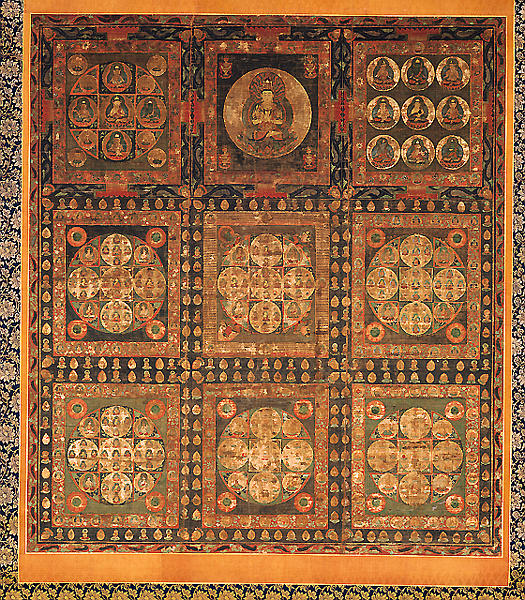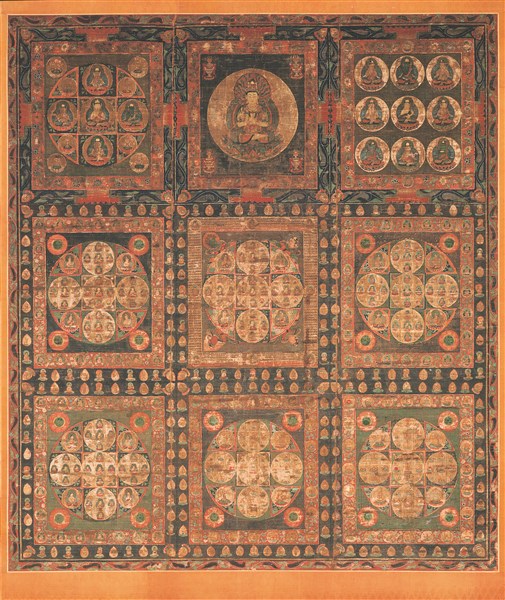両界曼荼羅図
- 室町時代
- 14-15c
- 絹本著色
- H-138.5 W-122.2
- 所蔵
- 教王護国寺(東寺)伝来
室町時代 14-15世紀
絹本著色
(各)縦:138.5cm 横:122.2cm
両界曼荼羅図は密教の根本本尊画像で,『大日経』に基づく胎蔵界と,『金剛頂経』に基づく金剛界とからなる。この両経典は,インドにおける密教の発展経過では異なる段階に属しているが,これを一対として扱い両界図に仕上げたのは,空海の師恵果阿闍梨であったとみなされている。胎蔵界は厳密には「大悲胎蔵生曼荼羅」と呼び,「界」字をつけないのが正式だが,天台密教の大家安然の頃から金剛界にあわせて「界」をつけて呼ばれるようになった。
空海が請来した最初の両界図を根本曼荼羅といい,その図像の系統に属するものを「現図」といっている。高雄曼荼羅や東寺に伝わる根本曼荼羅の転写本がその代表である。しかし空海以降にも,空海とは別の系統の両界曼荼羅図が請来されている。東寺の西院曼荼羅は円珍の請来画像に基づくとされ,現図とは若干異なるし,天台系と思われる大阪・四天王寺本や兵庫・太山寺本など,明確に現図とは別系のものもある。
本作品は胎蔵界の虚空蔵院(画面の下方)両側にいる千手観音像と金剛蔵王菩薩のそれぞれ手前に供養壇が設けられている点で,現図系ではなく天台系と共通する特色をもつ。ただし天台系図像では,往々にして中台八葉院(画面中央)の東方仏と北方仏の図像が入れ替わることが多いのに対し,本作品は現図と同じ像容をもつ。また,金剛界は通常の九会から構成されているが,微細会(向かって右下)では諸尊の背に描かれるはずの金剛杵の足が見えないのは,時代の下降による省略であろうか。
いずれにしろ,現図系とは異なる両界図とみなされる。制作時期は,絵絹の組織がやや粗くなっていることや尊像表現の形式化から,室町時代前半と考えられる。(泉)
後期大乗仏教の宇宙観
後期大乗仏教の宇宙観
300年頃から650年頃の大乗仏教は、中期に分類され、哲学的学問的な研究が行われ、哲学理論のうえからすれば最も優れた哲学を造り上げたものの、信仰実践という面がおろそかになったために、仏教自体は衰退していったようです。これを再び宗教的に復帰させようとして、7世紀ころから興ったのが密教と呼ばれる、後期大乗仏教です。
ここでは中期の哲学的な内容を象徴によって表現し、宗教的な実践と併せようと試みています。密教の宇宙観を伝える曼陀羅のうち、日本にも伝えられた「大日経」に基づく胎蔵界曼陀羅などを見ると、密教が実にたくましくインドの神々をも取り込みながら、平易に仏教の哲学を広めていった様を想像することができます。しかし、やがて逆にこの密教もインドの民間信仰のなかに飲み込まれ、13世紀の初頭頃にはついにインド本土からは姿を消すことになりました。
なお、密教はチベットにも伝えられ、多くの密教教典が翻訳されているほか、チベット仏教としてのラマ教を生みました。
Catalogue Entry
Muromachi period, 14th to 15th centuries
Pair of hanging scrolls, color on silk
Height, 138.5cm; width, 122.2cm (each)
The pair of mandalas known as the Ryokai Man-dalas are the central devotional images of the Esoteric sects of Buddhism--namely the Taizokai, or Womb World Mandala (Garbhaknos⇔a-mandala) based on the Dainichikyo sutra, and the Kongokai, or Diamond World Mandala (Vajradhatu-mandala) based on the Kongochokyo sutra. These two sutra texts emerged at different stages of the development of Esoteric Buddhism in India, and it was Kukai's teacher, Hui-kuo (746-805), who combined this pair of mandala images based on these two sutras. Strictly speaking, the formal name of the Taizokai mandala in Japanese is "Daihitaizo Sho Man-dara," omitting the character "kai" for world, but starting around the 9th century, during the lifetime of the major Tendai sect master, An'nen, the "kai" character was added to match the "kai" found in the name of the Kongokai mandala.
Kukai brought back Japan's first images of these two mandalas from China, and these two man-dalas are called the Konpon Mandalas, or root mandalas. The lineage of mandalas based on these Konpon Mandalas are known as "Genzu," or "original image," mandalas. The Takao Man-dalas and the Konpon Mandalas at Toji are considered the representative examples of these Genzu mandalas. Since Kukai, however, man-dala images from other lineages have been brought back to Japan from China. The Sai-in Mandalas of Toji are based on the mandala iconography brought back by Enchin, and they differ slightly from the Genzu iconography. Mandalas considered to be from the Tendai lineage, such as the Shiten'noji Mandala and the Taisanji Mandala, are clearly from a non-Genzu lineage.
In the present work, memorial altars have been placed in front of the Thousand-Armed Kannon (Avalokites⇔vara-sahasrabhuja-locana) and Kongo-zoo Bosatsu (Stottarasata-bhuja-vajra-dhara) on either side of the Kokuzoin section (lower section of the composition), and this is characteristic of a Tendai lineage mandala pair, as opposed to the Genzu lineage. The Tendai lineage iconography, however, frequently exchanges the positions of the eastern directional Buddha and the northern directional Buddha in the Chudai-hachiyo-in (central eight-petal court or center of the composition), and in the present work the deities are placed in their Genzu image positions. While the Kongokai normally consists of ku-e, or 9 precincts, the spikes of the vajra staffs which are supposed to be painted behind the various deities in the Misai-e (the lower right as the viewer faces the mandala) are not visible here, and this may represent an abbreviation of the original iconography over time.
In any event, this pair is unquestionably a Ryokai Mandala pair that differs from the Genzu lineage. In terms of period of production, the rough weave of the ground silk and the relatively rough and formalized depiction of the various deities suggest a date in the first half of the Muromachi period for the pair. TI
かざり 図録解説
両界曼荼羅図 かざり 図録解説
胎蔵界・金剛界よりなる両界曼荼羅は、密教の到達した最高の仏教理念を説く『大日経』『金剛頂経』に基づき大日如来を中心に諸尊を配置したものである。胎蔵界は密教の理の世界、金剛界は密教の智の世界を表すとされ、密教修法に不可欠なものとして天台・真言を問わず重要視されてきた。
胎蔵界曼荼羅は、母の胎内で命を育むような大日如来の無辺の慈悲が広がる様を表している。中央の区画には八葉蓮華をかたどり、その中心に大日如来、周りの八弁に胎蔵界四仏、四菩薩を配した中台八葉院を置いて、それを各院が囲む形で構成され、全部で十二院からなるとされる。
金剛界曼荼羅は、九つの曼荼羅からなる複合曼荼羅で、各曼荼羅を「会(え)」といい、金剛石のように頑健で輝くような大日如来の智慧を、厳重に区画することによって表現したものである。両界曼荼羅は空海によって唐より請来され、そののち天台の円仁、円珍によってももたらされたが、真言密教の根本曼荼羅として継承された、空海請来本による「現図曼荼羅」と呼ばれるものが最も流布された。
この両界曼荼羅は、金剛界に現図系の九会からなる構成を採用している一方、胎蔵界では、虚空蔵院の千手千眼観音と金剛蔵王菩薩の前に供養壇が設けられていることが天台系の曼荼羅と共通し、天台密教系の曼荼羅の様相を伝えているといえる。



